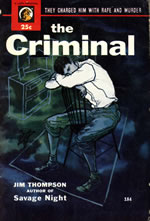The Criminal
 Cover Artist: not identified
Cover Artist: not identifiedBy: Thompson, Jim
Publisher: Lion Books, Inc.
Place of Publication:New York, NY
Catalog #: Kelley Box 381: PS3539 H6733 .C74 1953
Contributor: R. Farrell
General
Era: 1950sAuthor as on Cover: Jim Thompson
Publication:1953
Original Date: 1953
Setting: suburban; the story revolves around primarily middle to upper-middle class characters, although elements of the lower social strata also play a role. Characters are primarily white, though race becomes a theme with the introduction of a Jewish lawyer and a black family that subsists on the outskirts of the city.
Plot Summary
Bob Talbert, a disaffected fifteen-year-old living with his parents in the suburbs of a western city, is charged with the murder of Josie Eddleman, a neighbor's flirtatious teenage daughter, after a local newspaper in pursuit of larger circulation pressures the district attorney in order to create a story. Without an alibi and placed at the scene of the crime by his own admission, Bob's fate rests with men whose motives are all self-interested -- a unionizing reporter in a tenuous job position, an alcoholic editor with an ailing wife, a publisher as interested in playing God as increasing sales, and an ambitious district attorney, concerned with saving face in the public eye. The attorney hired by the Talberts to defend their son has one recourse for establishing an alibi for Bob: the uncooperative, embittered Negro mother of a large family whose husband was unjustly killed in the South by a plantation owner over a money dispute.Major Characters
Bob Talbert adolescent male; somewhat troubled fifteen year old who regularly skips school to caddy on the golf links. Described as an "overgrown young-un," Bob is going through puberty at the time of the novel's action.Allen Talbert adult male; father of Bob Talbert, husband of Martha; works at Henley Terrazo and Tile Company attempting to sell tile to builders and contractors. As the tile market is weak, and he is an aging presence in the company, his job is not at all secure.
Martha Talbert adult female, neurotic suburban housewife
Josie Eddleman adolescent female; murder victim; sexually experienced, she seduces Bob Talbert when the two, independently skipping school, encounter each other in the hillside near their homes.
Donald Skysmith adult male; college graduate and early success: Rhodes Scholar, Guggenheim Fellow and Pulitzer Prize winner, now the editor of the Star, a medium-sized newspaper in a two newspaper town. Dependent on a job he does not respect and cannot quit due to his dying wife's medical bills, he turns to alcohol in order to perform a job he finds unethical.
The Captain adult male; shadowy, unseen and seemingly all-knowing William Randolph Hearst-like publisher of the Star; orchestrates the Star's railroading of young Bob.
William Willis adult male; newspaper reporter assigned to sensationalize the murder case. As no one in the newspaper will willingly write the article, Willis is more or less blackmailed to write the piece. As a union organizer, the Captain would like nothing more than for Willis to quit or be fired. If he refuses the assignment, the Star's management would have a legitmate reason to fire him, thus ending his unionizing activities.
Hargreave Clinton adult male; district attorney, easily swayed by public opinion, and therefore by the newspapers; politically ambitious.
I. Kossmeyer adult male; Jewish attorney hired by the Talberts; complex character who walks the line between honesty and corruption.
Pearlie May Jones adult female; African-American woman raising her family on a small piece of land on the outskirts of the city. Suspicious of whites after the murder of her sharecropping husband in the South by a white plantation owner, she is a possible alibi for Bob.